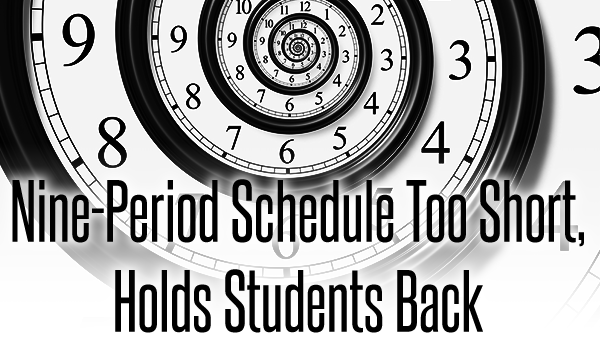
[UPDATE 2-17-15]
The board will open discussion on changing back to a A/B block schedule at an upcoming meeting. Since this story last ran, the purpose of moving to a nine-period day was to save money and force teachers to add another class teaching seven of eight classes, teachers now teach six of eight classes which is the same as a block schedule. There is no extra cost to move back to block scheduling. However, by changing back to A/B block, students would be more prepared for longer classes in college. They would have less stress of homework each night. They would be in class more because of less passing periods (75 more hours a year). They would not be rushed in and out a class with little instruction. Assuming the schedule would be the same at Ben Barber, they would not have to give up career tech classes which could fit in their schedule. On the current schedule students must give up three classes at their home campus for a career tech class. Everyone, especially the student, wins on block schedule.
The board should move forward with returning to a more successful, less stressful block schedule for students.
[January 2013]
With the intent to save money, the district moved from the A-B block system to the nine-period schedule after official approval at the board meeting May 3. With the implementation of the revised schedule, the district decreased the number of teachers at established schools without having to hire many new teachers for Lake Ridge. While the district gained financially from this arrangement, both students and teachers suffer repercussions.
Having nine periods in one day means students spend more school time walking to their classes during the passing periods, which amount to a total of 40 minutes of traversing through the halls. (Which totals up to 120 hours – 15 days of time outside of class.) In addition passing periods shrunk from seven minutes to five minutes, and the overall school day increased in length by 15 minutes. Shorter passing periods create problems of their own, since many students struggle to get to their classes on the opposite side of the building without tardiness. This time crunch combined with more classes to walk to each day makes students more physically exhausted, affecting their performance in class.
With the new schedule, students can receive assignments from up to eight different classes and teachers must grade and teach seven classes, one more than previous years. Experienced teachers with set agendas had to change their entire lesson plans to accommodate the 45-minute class periods as well. While giving teachers seven classes keeps the district from having to hire new teachers and allows them to keep all of the offered courses, it also harms teachers by making them perform more work for the same wages.
By the end of the school day, teachers would have repeated themselves numerous times. Students also listen to eight different lectures throughout the day, decreasing their attention spans as the day progresses.
The district tried to assist the student body by forming a homework policy, defining when a teacher could have students turn in work or take quizzes and tests. While this policy meant to rectify the problems students have faced with work, it merely moved the problems into large clusters of due dates throughout the week. Furthermore, it interrupted teachers’ class work schedules by confining teachers to handing out assignments and testing students’ knowledge to certain days.
If the district really desires to balance the new schedule and the repercussions created by it, it should modify the policies they have put in place based on the complaints of its students and teachers. The homework policy should mimic the previous year in that teachers could not assign work they made due the following day because of the nature of the A-B block system, and administrators give students more time for passing periods. With modifications to the existing policies, the district would alleviate some of the stress caused by the nine-period schedule.
